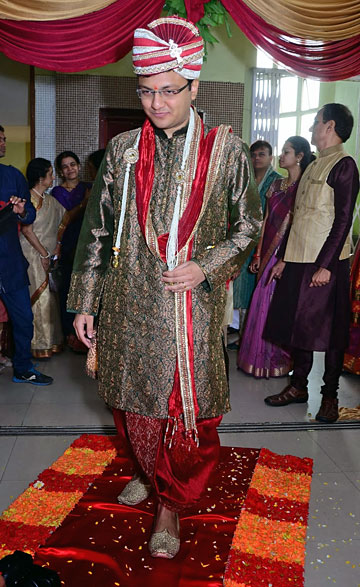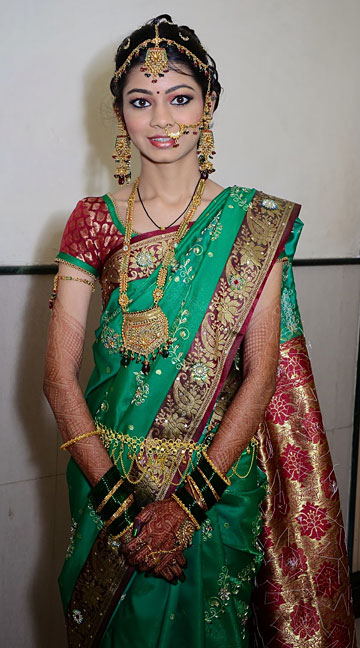An Indian Chess Wedding
Pictorial report by Sagar Shah

Sagar Shah, Elo 2304, two IM norms, and Amruta Mokal, Elo 2041, four WIM norms
When I met Amruta Mokal back in 2008, it was not at all clear that she would be the girl that I would marry. But over time, the attraction developed into liking, and liking into love! And after five and a half years, on February 5th 2014, we both tied the knot! The wedding was held in the city of Pune which is the hometown of the bride!

The invitation cards were designed by Amruta, keeping the overall chess theme in mind!
Let me first put things into perspective. Both me and Amruta wanted a different sort of wedding. Indian weddings are not only known for their pompous nature, but also for their excruciatingly long ceremonies and rituals. We wanted to break the monotony, and what better way than to celebrate the very reason of us coming together i.e. the game of chess!

We had already shown our chessic bias in July 2013, when Amruta specifically
designed our engagement rings in the shape of the chess king and queen!
But this time it was bigger! There were going to be nearly 500 people who would attend the wedding. In order to give tribute to the game of chess, we decided to decorate the stage with chess pieces!

The S next to the king stands for the name of the groom, and the A next to the queen for the name of the bride! Usually the wedding dresses of the bridegroom and bride are quite elaborate in an Indian wedding. So lets have a look at how the protagonists dressed up for the event!

The bridegroom, me, came well prepared for this game! The turban on the head is usually worn by kings and hence gives a royal look to the groom. The shirt is known as a sherwani and is quite intricately woven. The red scarf around my neck is called a dupatta and makes the dress aesthetically pleasing. In place of trousers I am wearing a dhoti. In the earlier days tying a dhoti was an art in itself, nowadays you can find readymade dhotis for amateurs like me. And finally in place of shoes I am wearing something known as mojdi. They are designer slippers which go well with the overall dress.
On that particular day I did feel like a king, because of my attire!

Amruta looked nothing short of a princess. There were so many minute details in her dress that it will take many lines to describe it. Let me make an attempt:
The dress is known as a saree. Its the most popular kind of attire for women in India. The material of the saree is silk and the green colour is considered auspicious during rituals. Amruta is wearing a lot of jewellery, for example the one of her head, connected to the nose, the ones in her ears, around her neck, forearms and around her waist. The bangles in her hand in green and gold colour are known as chuda and are supposed to be worn by a newly wed bride. The brown colour on her hands is known as mehendi. Almost every bride applies it in order to look beautiful.

Don't miss the chess king on Amruta's right forearm and the chess queen on her left!
 If you look at the image of Amruta, you will observe that she is wearing a lot of jewellery. In Indian weddings it is a tradition that the bride should only wear jewellery made of gold. Due to this tradition, many poor families are under a lot of stress when it comes to the marriage of their daughters. Thus whenever a girl is born in traditional families, it is still considered a great burden.
If you look at the image of Amruta, you will observe that she is wearing a lot of jewellery. In Indian weddings it is a tradition that the bride should only wear jewellery made of gold. Due to this tradition, many poor families are under a lot of stress when it comes to the marriage of their daughters. Thus whenever a girl is born in traditional families, it is still considered a great burden.
Amruta tried in her own little way to change the prevailing rigid traditions of Indian marriage – by wearing aritificial jewellery that was not made of gold. Maybe this little act will give other girls the confidence and show people that it is not always necessary to spend a lot of money for a wedding, and thus reducing the burden on their parents.
Saying no to gold may reduce female infanticide in India.
Chess players at the wedding

The wedding was well attended by a lot of chess players. Most notable amongst them were India's number nine GM Vidit Gujarathi (2602), GM Abhijit Kunte (2439), IM Swapnl Dhopade (2424), Indias latest IM Sameer Kathmale (2398), IM C.S. Gokhale (2248) and many other strong players, like Aniruddh Deshpande, Abhishek Kelkar, Chinmay Kulkarni, Shashikant Kutwal, Sohan Phadke, Vinod Bhagwat, Atul Dahale and Niklesh Jain.

The groom is flanked by two GMs: Vidit Gujarathi and Abhijit Kunte

One person who was definitely going to be present at the wedding was
IM and FIDE Trainer Prathamesh Mokal, who is Amruta's brother!

This is how the guests signed the wedding greetings
The caste system in India
Every person, just on the basis of his or her birth, is attached to a specific caste. The castes in Hindu religion are Brahmins, Kshatriyas, Vaishyas and Kshudras. Then there are sub castes, and this classification goes on and on. Though the awareness is increasing now, many people still try to find their partner from the same caste, in order to lead a similar family life before and after marriage. However the problem is very simple. People from one caste think that their caste is superior to the other. Clear lines have been drawn. The caste system is one of the prime reasons for inequality in Indian society.

[Addendum: Prof. Nagesh Havanur informs us that the above pyramid is an oversimplification and as such misleading. "The Indian caste system today is a complex jungle with a mind-boggling set of multiple identities, customs and rituals within," Prof Havanur writes. "It can no longer be reduced to four broad parameters. There is no separate caste called the untouchables: those who performed the most menial tasks among the shudras were not supposed to be touched by the others. So they were called asprashya (untouchable). Currently the shudras are called dalits in political parlance and the name has stuck. The time-honoured practice was to call only the vaidika Brahmins (priests) dvija or twice-born. In modern times nobody is called a dvija because no one follows the traditional path.]
Aamir Khan, a very famous Indian actor, says inter-caste marriage is the only way to get rid of this caste system in India. Amruta and I are not only from different castes, but also speak different languages at home. While she is a Maharashtrian, I am Gujarati. The thing which binds us is not any caste or religion but love – and to some extent the game of chess! The advantage is that each one of us can learn the other person's language, rituals, traditions and customs and thereby increase our knowledge. In any case the bottom line is simple: you marry the boy/girl you love, without thinking about the caste or religion.
See also:

























 If you look at the image of Amruta, you will observe that she is wearing a lot of jewellery. In Indian weddings it is a tradition that the bride should only wear jewellery made of gold. Due to this tradition, many poor families are under a lot of stress when it comes to the marriage of their daughters. Thus whenever a girl is born in traditional families, it is still considered a great burden.
If you look at the image of Amruta, you will observe that she is wearing a lot of jewellery. In Indian weddings it is a tradition that the bride should only wear jewellery made of gold. Due to this tradition, many poor families are under a lot of stress when it comes to the marriage of their daughters. Thus whenever a girl is born in traditional families, it is still considered a great burden.









